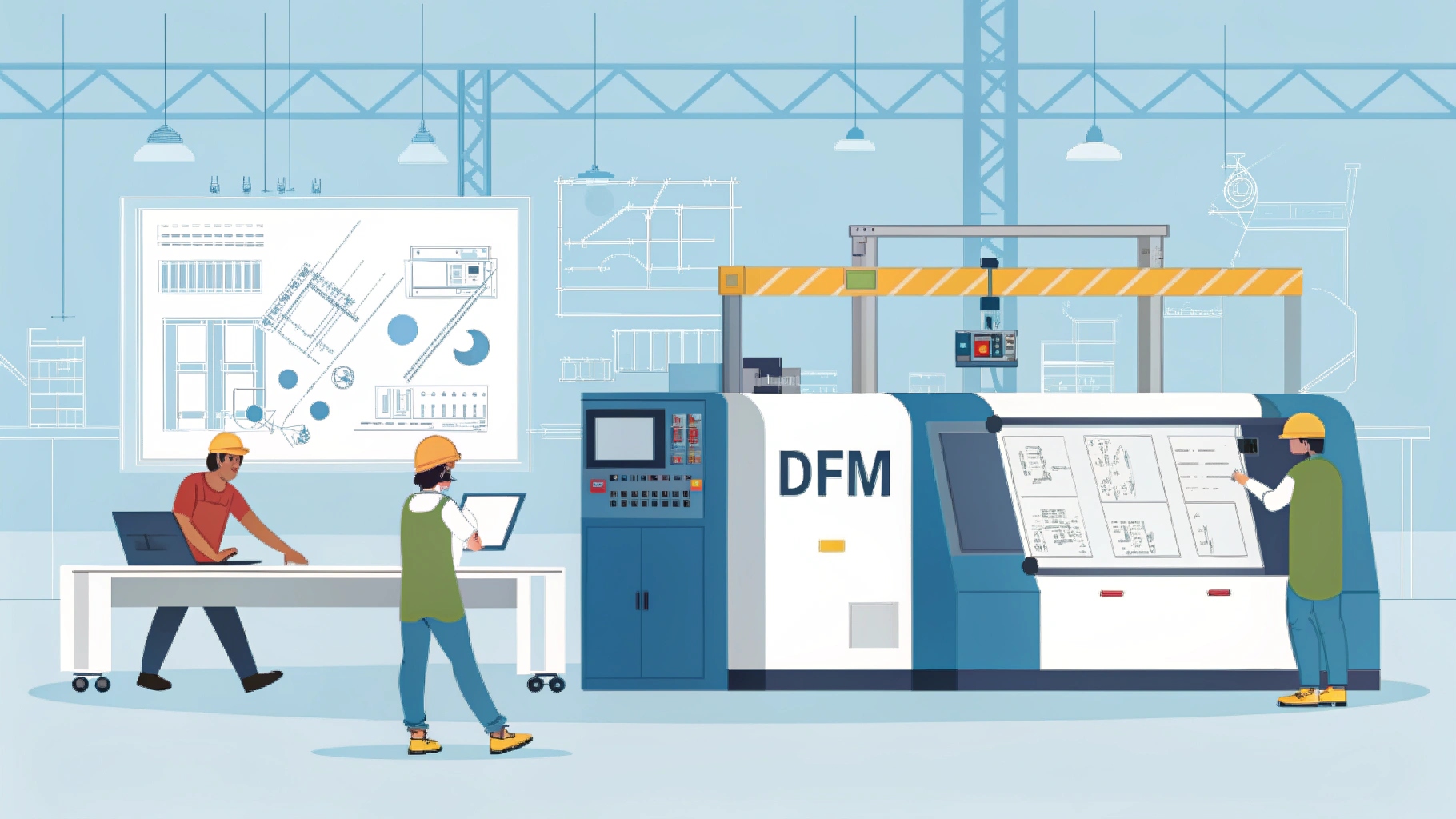In the fast-paced manufacturing world, delivering high-quality products while controlling costs is more critical than ever. That’s where Design for Manufacturing (DFM) steps in.
Design for Manufacturing (DFM) is a strategic approach that focuses on optimizing a product's design to simplify manufacturing processes1, reduce costs, and improve quality. It bridges the gap between engineering creativity and practical production methods.

When done right, DFM can streamline production, save costs, and improve product quality. Let’s dive deeper into its principles, benefits, and industry practices.
What is Design for Manufacturing (DFM)?
The growing complexity of product designs often increases manufacturing challenges, leading to higher costs and inefficiencies. DFM aims to address these issues at the design stage.
Design for Manufacturing (DFM)2 is the practice of designing products in a way that makes them easier, faster, and more cost-effective to manufacture. It ensures design decisions align with manufacturing capabilities and constraints.
The Essence of DFM
At its core, DFM is about collaboration between design engineers and manufacturing teams. By considering manufacturing methods, material selection, and production processes early on, designers can prevent potential issues like over-engineering or assembly complications.
A Simple Example
Imagine designing a part with unnecessarily tight tolerances. While it might look great on paper, it could be expensive and time-consuming to produce. With DFM, such issues can be identified and resolved before production starts.
Key Principles of DFM
Creating manufacturable designs requires a set of guiding principles. These ensure that the design phase aligns with production efficiency.
The key principles of DFM are: standardization, simplification, material selection3, process optimization4, and cost-effectiveness. Each principle directly impacts production outcomes.

Dive Deeper: Understanding the Core Principles
1. Standardization
Using standardized components5 and materials simplifies production and reduces lead times. For instance, a design that uses common screw sizes minimizes the need for special tools or parts.
2. Simplification
A simpler design is easier to manufacture. Eliminating unnecessary features or combining parts into a single component can save time and resources.
3. Material Selection
Choosing materials compatible with available manufacturing processes avoids issues like machining difficulties or material waste.
4. Process Optimization
Aligning the design with efficient manufacturing methods—such as CNC machining, molding, or stamping—ensures better cost control and fewer production challenges.
5. Cost-Effectiveness
Balancing functionality and production costs is critical. Over-designing a product can inflate costs without adding value.
These principles aren’t just theoretical. They’re the backbone of successful manufacturing strategies across industries.
Benefits of Design for Manufacturing (DFM)
The advantages of DFM extend beyond cost savings. It’s about creating value throughout the product lifecycle.
DFM reduces production costs6, improves product quality7, shortens time-to-market8, and enhances communication between teams.
Dive Deeper: Exploring the Benefits
1. Cost Reduction
By identifying and eliminating inefficiencies early, DFM minimizes waste and reduces overall costs. For example, selecting a material that’s easier to machine can significantly cut production expenses.
2. Improved Quality
DFM ensures that designs are robust and manufacturable, reducing defects and improving consistency. This leads to fewer customer complaints and warranty claims.
3. Faster Time-to-Market
Efficient designs are quicker to produce. With fewer production issues, products reach the market faster, giving companies a competitive edge.
4. Enhanced Collaboration
DFM fosters teamwork between designers, engineers, and manufacturers. This collaboration reduces miscommunication and ensures everyone is aligned with project goals.
Challenges in Implementing DFM and How to Overcome Them
While DFM offers numerous benefits, adopting it isn’t without challenges. Resistance to change, lack of expertise, and technological limitations can hinder implementation.
The main challenges in implementing DFM include lack of cross-functional collaboration, outdated tools, and resistance to adopting new practices.

Dive Deeper: Overcoming Challenges
1. Resistance to Change
Many organizations stick to traditional design methods, fearing the time or cost of adopting DFM practices. Overcoming this requires demonstrating the clear ROI of DFM initiatives through pilot projects.
2. Lack of Expertise
Not all engineers are trained in DFM principles. Investing in training and hiring experienced professionals can address this gap.
3. Technological Limitations
Outdated tools and software can hinder DFM implementation. Upgrading to modern CAD systems with integrated DFM analysis can streamline the process.
4. Cross-Functional Barriers
Silos between design and manufacturing teams lead to misaligned goals. Encouraging open communication and collaboration resolves this issue.
By tackling these challenges head-on, organizations can fully realize the potential of DFM.
DFM Practices in Different Industries
DFM isn’t a one-size-fits-all solution. It adapts to the unique demands of various industries, from aerospace to medical equipment.
Different industries apply DFM in unique ways, focusing on their specific production challenges and goals.
Dive Deeper: Industry Applications
1. Aerospace
In aerospace, where safety is critical, DFM focuses on precision and material optimization9. Components are designed to withstand extreme conditions while being lightweight.
2. Automotive
The automotive industry prioritizes cost-effective mass production10. DFM ensures components are easy to assemble and maintain consistency across high volumes.
3. Medical Equipment
Medical devices require high precision and strict compliance with standards. DFM emphasizes material selection and process control to ensure safety and functionality.
4. Consumer Electronics
For consumer electronics, DFM focuses on miniaturization and ease of assembly11. Designs must balance aesthetics with manufacturability.
5. Industrial Machinery
DFM in industrial machinery prioritizes durability and ease of maintenance. Designs often incorporate standardized components to simplify repairs.
By tailoring DFM practices to industry needs, companies can maximize efficiency and product value.
FAQs about Design for Manufacturing
When implementing DFM, questions often arise about its applications and best practices. Here are some common FAQs:
-
What’s the difference between DFM and DFA (Design for Assembly)?
- DFM focuses on manufacturing efficiency, while DFA emphasizes simplifying product assembly.
-
Can DFM be applied to existing products?
- Yes, DFM principles can be used to redesign existing products for better manufacturability.
-
What tools are used for DFM?
- Modern CAD software with DFM analysis features is commonly used.
-
Does DFM only apply to large-scale production?
- No, DFM benefits both small-batch and large-scale manufacturing.
By addressing these questions, organizations can gain clarity on implementing DFM effectively.
Conclusion
Design for Manufacturing (DFM) is more than a set of principles; it’s a strategic mindset that drives efficiency and innovation. By embracing DFM, businesses can reduce costs, improve quality, and stay ahead in competitive industries.
-
Understanding the impact of simplifying manufacturing processes can lead to more efficient production lines and cost savings, essential for competitive advantage. ↩
-
Exploring best practices for DFM can significantly enhance product design efficiency, reduce costs, and improve quality, making it a must-read for professionals. ↩
-
This resource will explain the critical role of material selection in avoiding production issues and ensuring compatibility with manufacturing techniques. ↩
-
Discover how aligning designs with efficient manufacturing methods can lead to cost savings and fewer production challenges. ↩
-
Exploring this link will reveal how standardized components streamline production, reduce costs, and improve efficiency in manufacturing processes. ↩
-
Understanding how DFM reduces production costs can help businesses optimize their manufacturing processes and save money. ↩
-
Exploring how DFM improves product quality can lead to fewer defects and higher customer satisfaction. ↩
-
Learning about DFM's impact on time-to-market can give companies a competitive edge by accelerating product launches. ↩
-
Explore how material optimization enhances aerospace component performance and safety, crucial for extreme conditions. ↩
-
Learn how DFM strategies in automotive manufacturing reduce costs while maintaining high production volumes and quality. ↩
-
Discover the role of miniaturization in consumer electronics for creating compact, efficient, and easily assembled devices. ↩

